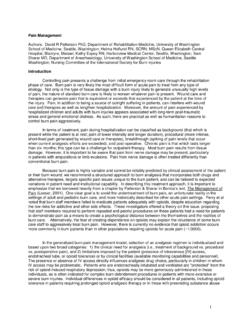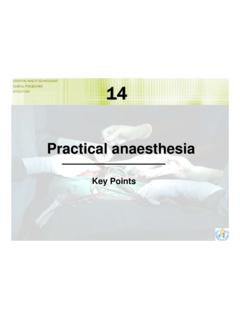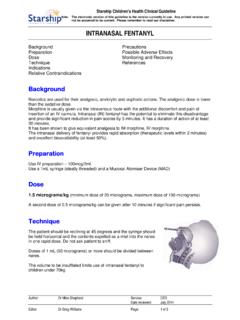Transcription of Brain Function Monitoring and itʼs Role in …
1 Brain Function Monitoring and it s Role in Anesthetic Management Michael Geisler, CRNA, BSN. Private Anesthesia Practitioner Ponte Vedra Beach, Florida Learning Objectives Explore the rationale for Monitoring Brain Function Review Bispectral Index (BIS) fundamentals Examine evidence-based results of BIS Monitoring Provide an update on Intraoperative Awareness Using case studies, illustrate BIS responses during anesthesia Discuss clinical applications and benefits of BIS Monitoring Why Monitor Consciousness? Anesthetic Effect Management BEST OUTCOMES. Quality + Safety Side-effects Complications Costs Adverse Outcomes Adverse Outcomes OVERDOSING ADEQUATE/OPTIMAL UNDERDOSING. ANESTHETIC DEPTH. 086-0092 1 Hemodynamics and Consciousness 1. Recovery of Consciousness after Thiopental or Propofol 180. BIS. Blood Pressure (MAP). 100 140. 80 100. 600 8. 60 2 4 6 10 12. Recovery of Time (minutes).
2 Consciousness* 150. Heart Rate (bpm). 40. 120. 20 90. 0 2 4 6 8 10 12 60. 0 Time (minutes) 30. 0 2 4 6 8 10 12. *Thiopental Induction (4 mg/kg) Time (minutes). Hemodynamic signs do not correspond with a state of awareness. 1. Flaishon R et al. Recovery of Consciousness after Thiopental or Propofol. Anesthesiology 1997; 86(3):613-619. Why Measure Brain Effects Directly? Hemodynamics lack precision and utility Poor correlation Anesthetic dose Sedation and consciousness Inherent patient variability Children/elderly patients Patients on cardiac medications Dosing considerations/restraints Elderly: Requirement and CV sensitivity Patient profiles: Obese, ESRD, ESLD. Altered requirements: Drug dependencies Intraoperative cardiovascular instability Bispectral Index (BIS) A practical, processed EEG parameter that measures the direct effects of anesthetics and sedatives on the Brain Numerical scale correlates to hypnotic endpoints Extensive clinical validation Provides objective information about an individual patient s response to anesthesia 086-0092 2 Signal Processing Donald R.
3 Stanski and Steven L. Shafer, Miller s Anesthesia, ed. Ronald D. Miller (Philadelphia: Elsevier Inc., 2005), p. 1252. EEG/BIS Response to Anesthetics Stanski DR, ShaferDL , Anesthesia, ed. Miller RD. (Philadelphia: Elsevier Inc., 2004), p. 1253. BIS Correlates with Brain Metabolism BIS Responds to Factors %BMR BIS. that Metabolic Rate 100 95 Anesthesia Temperature Natural sleep 64 66. Ischemia Neurologic disease Metabolic status 54 62. Glucose Thyroid Function 38 34. Alkire, Anesthesiology 1998; 89:323-333. 086-0092 3 Clinical Impact of BIS. Monitoring Meta-analysis Meta-analysis to examine the clinical impact of BIS Monitoring on anesthetic use, incidence of PONV, duration of PACU stay and time to discharge in ambulatory anesthesia. 11 randomized controlled trials enrolling 1,380 subjects Comparison of BIS Monitoring to standard practice (sp). Key Results BIS Monitoring : Significantly reduced anesthetic use by 19% compared to sp Reduced the incidence of PONV by 16%.
4 Reduced PACU time by 4 minutes Author estimated net cost of $ per patient Anesthesiology 2004; 101(2):311-315. Analysis. Liu SS. Effects of Bispectral Index Monitoring on Ambulatory Anesthesia: A Meta-analysis of Randomized Controlled Trials and a Cost Documented Anesthesia Benefit Summary Drug Savings Decreased PONV. (Gan, 1997; Bannister, 2001; Wong 2002; White 2004; Liu ,2004) (Nelskya, 2001; Luginb hl, 2003). % %. Control BIS Titrated Isoflurane Propofol Sevoflurane Desflurane Faster Wake-Ups Shorter PACU Stays (Gan, 1997) (White, 2004). Minutes %. Standard Practice BIS-Titrated Standard Practice BIS-Titrated Documented Benefits in Children BIS-guided titration during general anesthesia: Correlates with the hypnotic component of anesthetics accurately reflecting level of consciousness Improves titration of general anesthetics 25-40% reduction in measured recovery times Useful during pediatric anesthesia, including cardiac Denman WT et al.
5 Anesthesia & Analgesia 2000; 90 (4): 872-877. Degoute CS et al. British Journal of Anaesthesia 2001; 86(2): 209-212. Davidson AJ et al. Anesthesia & Analgesia 2001; 93 (2): 326-330. Laussen PC et al. Paediatric Anaesthesia 2001; 11 (5): 567-573. Bannister CF et al. Anesthesia & Analgesia 2001; 92 (4):877-881. Johansen JW. Anesthesia & Analgesia 1998; 86: S406. 086-0092 4 Is Intraoperative Awareness a Problem? General Incidence: Sandin, Lancet 2001; Sebel, Anesth Analg 2004. Preoperatively, many patients are concerned Royston & Cox, Lancet 2003;362:1648-58. Patients would pay $35 to prevent awareness Gan, J Clin Anesth 2003; 15:108-12. Highest risk factor for patient dissatisfaction Myles et al. BJA 2000; 84: 6-10. 65% of patients do not tell their anesthetist Moerman et al. Anesthesiology 1993; 79:454-464. Patient Concerns Before Anesthesia N Death Awareness Pain PONV 382 23% 19% 5% 6% 100 15% 15% - - 5% 129 54% - - 22% 800 37% 24% 34% 22% 166 43% 52% 38% - - 132 19% - - 39% - - 1216 12% 20% 9% 12% Royston & Cox, Anesthesia: the patient s point of view.
6 The Lancet 2003;362:1648-58. Awareness in the United States Awareness Incidence by Site Awareness Incidence %. 1 case per 500. 1 case per 1000. 0. al 1. 2. 3. 4. 5. 6. 7. t te te te te te te te To Si Si Si Si Si Si Si Large, prospective, multicenter study 19,576 Patients interviewed Postoperatively and after one week Convenience sampling of all patients types Sebel et al Anesth Analg 2004; 99:833-9. 086-0092 5 Why Does Awareness Occur? Selection of Mechanical inadequate Resistance to malfunction or anesthetic anesthetics misuse of anesthetic dose machine INADEQUATE. ANESTHETIC. EFFECT. CONSCIOUSNESS. EXPLICIT RECALL. Ghoneim MM, Awareness During Anesthesia. Anesthesiology 2000; 92:597-602. JCAHO Sentinel Event Alert Issue 32 . Preventing, and managing the impact of, anesthesia awareness . +us/news+letters/sentinel+event+ Definition, Role of NMB. Patient Experience & Sequelae Incidence ( ).
7 High risk Scenarios Current Monitoring Limitations Brain Monitoring devices Anesthesia Challenge: Balance psychological risk vs. physiologic risk Recommendation: Develop Awareness Policy Brain Function Monitoring in Anesthesia Practice Practice Advisory for Intraoperative Awareness and Brain Function Monitoring A Report by the American Society of Anesthesiologists Task Force on Intraoperative Awareness Not routinely indicated for general anesthesia patients The decision to use a Brain Function monitor should be made on a case-by-case basis by the individual practitioner for selected patients Adopted by ASA House of Delegates, October 2005. 086-0092 6 Emerging Role of Brain Monitors ASA Practice Advisory Member Survey Brain Function monitors are valuable and should be used to reduce the risk of intraoperative awareness for patients with conditions that may place them at risk for intraoperative awareness.
8 Strongly Agree Agree Uncertain Disagree Strongly Disagree Avoiding Awareness Algorithm 1. Assess Individual Risk 2. Change Care Appropriate to Risk 3. Use Multiple Modalities Broad Clinical Applications BIS Monitoring Patients Elderly Pediatric Obese Labile Medically-compromised Organ dysfunction Procedures Outpatient procedures Increased awareness risk Cardiac surgery cardiac, trauma, obstetric, Neurosurgery expected hypotension, airway Office procedures surgery, limited cardiac reserve Techniques Volatile-based anesthesia MAC & Procedural Sedation IV-based anesthesia Perioperative Adjuvant therapy Combined regional-general Beta-blockers, Alpha-2 agonists Muscle relaxant use Closed loop anesthesia 086-0092 7 BIS Sample Profile: GA. Patient Management Table Strategy for intraoperative management based on integration of BIS index value with observed clinical response. Patient management should never be based on BIS Monitoring information alone.
9 Physical Clinical BIS Management strategy signs profile Index*. Assess level of surgical stimulation Confirm delivery of hypnotics/analgesics High value Consider hypnotic / analgesic dosing Consider antihypertensive administration Hypertension Tachycardia Assess level of surgical stimulation Light Desired range (45-60) Consider analgesic dosing Movement Consider antihypertensive administration Autonomic responses Consider antihypertensive administration Low Value Assess level of surgical stimulation Consider hypnotic / analgesic dosing *Potential impact of artifact should be considered when interpreting BIS values. Adapted from Stanski DR, Shafer DL. Anesthesia, ed. Miller RD. (Philadelphia: Elsevier Inc., 2004) p. 1257. Important Information about Using BIS. Monitoring Clinical judgment should always be used when interpreting BIS in conjunction with other available clinical signs.
10 Reliance on the BIS alone for intraoperative anesthetic management is not recommended. As with any monitored parameter, artifacts and poor signal quality may lead to inappropriate BIS values. BIS values should be interpreted cautiously in patients: with known neurological disorders taking psychoactive medications in children below the age of one 086-0092 8 Important Considerations EMG Tone & Neuromuscular blockers may influence BIS. EMG Artifact: Excessive forehead muscle tone may increase BIS. Administration of NMB may alleviate EMG artifact & decrease BIS. During stable anesthesia without EMG artifact, NMB have no BIS. effect Mechanical and electrical artifacts may increase BIS values Forced-air warmers, surgical navigation systems Pacemakers, endoscopic shaver devices Certain anesthetics may produce different BIS. responses Ketamine Halothane Dahaba AA, Anesth Analg 2005; 101:765-73.




